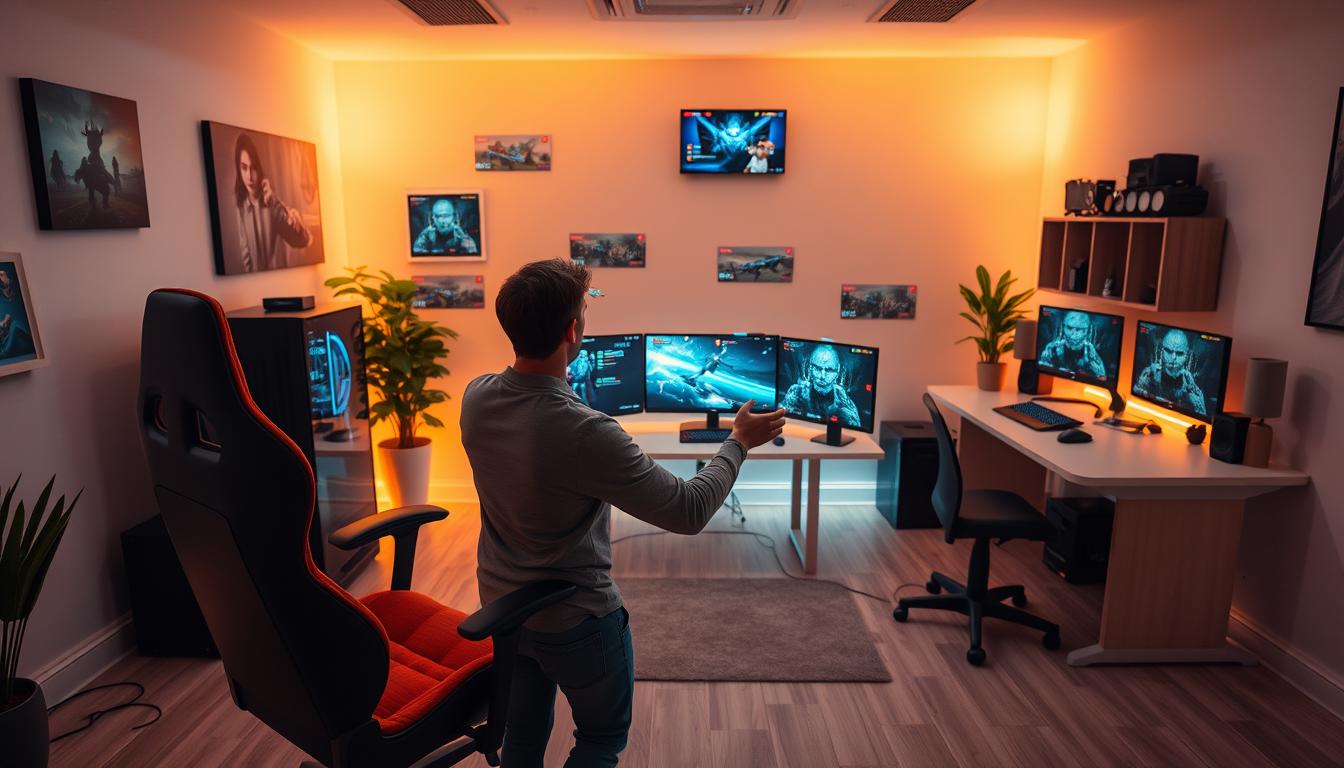The gaming industry has witnessed significant advancements in recent years, with gaming technology evolving to provide a more immersive experience. One of the emerging trends is the use of voice commands in gaming, allowing players to interact with games using voice instructions.
The evolution of game controls has been a gradual process, from traditional controllers to motion-sensing devices. The introduction of voice commands represents a new frontier in this evolution, raising questions about its voice control practicality.
As we explore the potential of voice commands in gaming, we must consider whether this technology is ready for mainstream adoption.
Key Takeaways
- The use of voice commands is a growing trend in the gaming industry.
- Gaming technology is evolving to provide a more immersive experience.
- The practicality of voice commands in gaming is still being questioned.
- The evolution of game controls has been a gradual process.
- Voice commands represent a new frontier in game controls.
The Evolution of Game Controls
The way we interact with games has undergone a significant transformation over the years. From the early days of simple, button-based controls to the sophisticated systems we see today, the evolution of game controls has been a pivotal aspect of the gaming industry’s growth.
From Joysticks to Motion Controls
The journey began with joysticks, which were among the first devices used to control games. As technology advanced, so did the complexity and capability of game controllers, introducing motion controls that allowed for a more immersive experience. The introduction of motion controls marked a significant shift, enabling players to engage with games in a more physical and interactive way.
The Emergence of Voice Recognition in Gaming
More recently, the integration of voice recognition technology has opened new avenues for game interaction. Voice commands offer a hands-free experience, enhancing gameplay and accessibility. This technology is still in its early stages but has the potential to revolutionize how we interact with games, making it a significant step in the evolution of game controls.
How Voice Command Technology Works in Games
Voice command technology is revolutionizing the gaming industry by providing players with a more immersive and interactive experience. This technology enables players to control games using voice commands, enhancing gameplay and interaction.
Voice Recognition Systems Explained
Voice recognition systems are a crucial component of voice command technology in games. These systems use complex algorithms to recognize and interpret voice commands, allowing players to control the game.
Natural Language Processing in Gaming
Natural Language Processing (NLP) plays a vital role in voice recognition systems, enabling the system to understand and process human language. NLP allows the system to identify specific commands and execute them in the game.
Machine Learning and Adaptation
Machine learning is another key aspect of voice command technology, allowing the system to adapt to the player’s voice and commands over time. This adaptation improves the accuracy and responsiveness of the voice command system.
Integration with Game Mechanics
The integration of voice command technology with game mechanics is crucial for a seamless gaming experience. By incorporating voice commands into game mechanics, developers can create more immersive and interactive gameplay experiences.
| Game Mechanics | Voice Command Integration | Benefits |
|---|---|---|
| Character Control | Voice commands for movement and actions | Enhanced immersion and control |
| Menu Navigation | Voice commands for menu options | Streamlined navigation and reduced lag |
| Combat and Strategy | Voice commands for complex actions | Increased complexity and realism |
Current Implementation of Voice Commands in Popular Games
The integration of voice commands in gaming has become increasingly prevalent across various platforms, enhancing the gaming experience with more intuitive controls.
Console Games with Voice Control Features
Console gaming has seen significant advancements with the incorporation of voice commands, particularly in the latest generations of gaming consoles.
Xbox Series X/S and Kinect Legacy
The Xbox Series X/S consoles have built upon the legacy of Kinect, offering a range of voice-controlled features. Players can use voice commands to navigate menus, control media playback, and even interact with certain games. For instance, players can issue commands like “Xbox, go to the store” or “Xbox, record that” to manage their gaming experience hands-free.
PlayStation5 Voice Command Capabilities
The PlayStation 5 also supports voice commands, allowing players to access various functions without needing to physically interact with their console. Sony has integrated voice control into its system, enabling users to perform tasks such as opening the control center or searching for games using voice commands.
PC and Mobile Voice-Controlled Games
PC and mobile gaming platforms have also adopted voice command technology, offering gamers more flexibility and control.
Steam and Discord Voice Integration
Steam and Discord, two of the most popular PC gaming platforms, have integrated voice control features. Steam allows users to control certain aspects of the platform using voice commands, while Discord enables users to manage their communications and interactions within the platform more easily.
Mobile Games Utilizing Voice Commands
Mobile games are also leveraging voice command technology to enhance gameplay. Some titles allow players to control characters or navigate menus using voice commands, adding a new layer of convenience and immersion to the gaming experience.
Some notable examples of voice-controlled games include:
- Tom Clancy’s Rainbow Six Siege on PC and console, which allows players to communicate with teammates using voice commands.
- Mobile games like Pokémon Go, which use voice commands for certain in-game actions.
Voice Commands as Game Controls – Is It Practical?
As voice technology advances, the question remains: are voice commands a viable option for game controls? The debate surrounding the practicality of voice commands in gaming is multifaceted, involving factors such as response time, accuracy, and comparison with traditional input methods.
Response Time and Accuracy Considerations
The effectiveness of voice commands in gaming largely depends on the response time and accuracy of the voice recognition system. Advanced voice recognition technologies have made significant strides in reducing latency and improving accuracy. However, the complexity of commands and the environment in which the gamer is operating can still affect performance.
For instance, in fast-paced games where quick reflexes are crucial, any delay in command execution can be detrimental. On the other hand, games that require strategic planning might benefit more from voice commands, as players can issue complex instructions without being hindered by button combinations.

Comparing Voice Controls to Traditional Input Methods
When evaluating the practicality of voice commands, it’s essential to compare them to traditional input methods like controllers and keyboards. This comparison involves analyzing speed and precision.
Speed and Precision Analysis
Traditional input methods have been optimized over years to provide both speed and precision. For example, a gamer can quickly navigate through menus or execute complex button combinations with ease. Voice commands, while improving, still face challenges in these areas, particularly in noisy environments or when commands are complex.
Complexity of Commands vs. Button Combinations
One of the significant advantages of voice commands is their ability to simplify complex actions. Instead of memorizing and executing intricate button combinations, players can issue a single voice command. This can enhance the gaming experience, especially in games that require multitasking or complex instructions.
However, the practicality of voice commands ultimately depends on the specific requirements of the game and the preferences of the gamer. As technology continues to evolve, we can expect voice commands to become an increasingly viable option for game controls.
Benefits of Voice Commands in Gaming
Voice commands are revolutionizing the gaming industry by offering a more immersive experience. This section will explore the various benefits that voice commands bring to gaming, enhancing the overall experience for players.
Enhanced Immersion and Gameplay Experience
Voice commands allow players to engage more deeply with the game, creating a more immersive experience. By using voice commands, players can interact with the game environment in a more natural way, which enhances the gameplay experience.
For instance, in role-playing games, players can use voice commands to instruct their characters, making the game feel more interactive and immersive.
Multitasking Capabilities During Gameplay
Voice commands enable players to multitask during gameplay, issuing commands without the need to pause or navigate through menus. This capability enhances the overall gaming experience by allowing players to manage multiple tasks simultaneously.
| Game Type | Multitasking Benefits | Voice Command Advantages |
|---|---|---|
| Strategy Games | Manage resources, issue commands | Quick execution, reduced UI clutter |
| Role-Playing Games | Character control, inventory management | Enhanced immersion, streamlined gameplay |
Strategic Advantages in Complex Games
In complex games, voice commands can provide strategic advantages by allowing players to quickly issue commands, manage resources, and coordinate with team members more efficiently.
Reducing UI Clutter Through Voice
By utilizing voice commands, players can reduce UI clutter, as they don’t need to constantly navigate through menus or press multiple buttons. This simplification enhances the gaming experience, making it more enjoyable and interactive.
Overall, the integration of voice commands in gaming offers numerous benefits, from enhanced immersion and multitasking capabilities to strategic advantages and reduced UI clutter.
Challenges and Limitations of Voice Control
Voice control technology, while innovative, faces several challenges that hinder its seamless integration into gaming. One of the primary concerns is the technical hurdles and recognition issues that affect the accuracy and responsiveness of voice commands.
Technical Hurdles and Recognition Issues
Voice recognition systems struggle with various dialects and accents, leading to misinterpretations and incorrect commands. This issue is compounded by background noise interference, which can significantly degrade the performance of voice controls.
Dialect and Accent Recognition Problems
The diversity in dialects and accents poses a significant challenge for voice recognition systems. For instance, a gamer with a thick accent may find that their voice commands are not recognized accurately, leading to frustration and a poor gaming experience.
Background Noise Interference
Background noise is another factor that can severely impact the effectiveness of voice controls. Noisy environments can cause the system to misinterpret commands or fail to recognize them altogether.
Environmental Factors Affecting Performance
Environmental factors, such as the physical setup of the gaming area and the quality of the hardware used, can also affect the performance of voice controls. For example, the distance between the gamer’s mouth and the microphone, as well as the presence of reflective surfaces, can influence the accuracy of voice recognition.
The following table summarizes the key challenges faced by voice control technology in gaming:
| Challenge | Description | Impact |
|---|---|---|
| Dialect and Accent Recognition | Struggling to understand diverse dialects and accents | Incorrect or unrecognized commands |
| Background Noise Interference | Noise interfering with voice commands | Degraded performance and frustration |
| Environmental Factors | Physical setup and hardware quality affecting performance | Variable accuracy and responsiveness |

Voice Commands in Virtual Reality and AR Gaming
As VR and AR technologies advance, the role of voice commands is expanding, enabling gamers to engage with games in new ways. Voice commands offer a hands-free control mechanism that is particularly suited to immersive gaming environments.
Hands-free Control in Immersive Environments
The use of voice commands in VR and AR gaming allows for a more immersive experience, as players can interact with the game world without the need for physical controllers. This hands-free control enhances the sense of immersion and can make gameplay more intuitive.
Case Studies: VR Games with Voice Integration
Several VR games have successfully integrated voice commands, showcasing the potential of this technology. Let’s examine a few examples:
Social VR Platforms and Voice Interaction
Social VR platforms like VRChat have incorporated voice chat, allowing users to communicate with each other in real-time. This feature enhances the social aspect of VR gaming, making it more interactive and engaging.
Single-Player VR Experiences with Voice Commands
Some single-player VR games, such as “The Lab,” have also utilized voice commands for gameplay mechanics. Players can issue voice commands to interact with objects or navigate through menus, adding a layer of convenience to the gaming experience.
| Game Title | Voice Command Feature | Gaming Experience |
|---|---|---|
| VRChat | Real-time voice chat | Enhanced social interaction |
| The Lab | Voice-controlled gameplay mechanics | Increased convenience and immersion |
In conclusion, voice commands are set to play a significant role in the future of VR and AR gaming, offering a more immersive and interactive experience for gamers.
Accessibility Implications of Voice Controls
The integration of voice commands in games has significant implications for accessibility, particularly for players who face challenges with traditional gaming controls.
Gaming for Players with Physical Limitations
Voice controls offer a new level of freedom for gamers with physical disabilities. For instance, players with mobility impairments can navigate game menus and interact with game environments using voice commands. According to a study by the Accessibility in Gaming Initiative, voice-controlled games can increase participation among players with disabilities by up to 30%. This technology has the potential to revolutionize gaming for players with physical limitations, enabling them to engage more fully with their favorite games.
| Benefit | Description |
|---|---|
| Increased Accessibility | Voice controls allow players with physical disabilities to play games more easily. |
| Enhanced Gameplay | Players can multitask and perform complex actions using voice commands. |
Language and Accent Considerations
While voice controls offer many benefits, there are also challenges related to language and accent. Different accents and dialects can affect the accuracy of voice recognition systems. As
“The future of gaming lies in its ability to adapt to diverse player needs, including those with varying linguistic backgrounds.”
noted by a leading game developer, addressing these challenges is crucial for ensuring inclusivity.
To mitigate these issues, game developers are working to improve voice recognition technology, incorporating more diverse language datasets and refining algorithms to better understand varied accents. For example, some games now include training modes that help the system learn the player’s voice and accent.
User Experiences and Community Feedback
The integration of voice commands in gaming has sparked a diverse range of user experiences and community feedback. As gamers adapt to this new technology, their responses vary widely, reflecting different gaming preferences and habits.
Competitive Gaming Considerations
In competitive gaming, voice commands can offer a significant edge, allowing for quicker commands and multitasking. However, some competitive gamers express concerns about the accuracy and response time of voice commands, which can be critical in high-stakes games.
Casual Gamer Perspectives
Casual gamers, on the other hand, often appreciate the ease of use and accessibility that voice commands provide. It simplifies gameplay and enhances the overall gaming experience, making it more enjoyable and less intimidating.
Family-Friendly Gaming with Voice Controls
Voice controls have also made gaming more family-friendly, enabling a more interactive and engaging experience for players of all ages. Games that utilize voice commands can be enjoyed together, fostering a fun, collaborative environment.
Social Gaming Experiences
In social gaming, voice commands facilitate more natural and immersive interactions. Players can communicate and control the game simultaneously, enriching the social aspect of gaming and creating a more dynamic experience.
Overall, the community’s feedback on voice commands in gaming is shaping the future of this technology, influencing how it is developed and integrated into various gaming platforms.
The Future of Voice Commands in Gaming
Voice commands in gaming are on the cusp of a significant transformation, driven by advancements in AI and natural language processing. This evolution is expected to enhance the gaming experience, making it more immersive and interactive.
AI Advancements and Natural Language Processing
The integration of AI and natural language processing (NLP) is crucial for the future of voice commands in gaming. AI algorithms can learn and adapt to a player’s voice, improving command recognition over time. NLP enables more complex commands, allowing for a more natural interaction between the player and the game.
Predicted Trends and Innovations
Several trends and innovations are predicted to shape the future of voice commands in gaming. These include:
- More sophisticated voice commands that can understand context and nuance.
- Integration with other technologies, such as gesture control and eye-tracking.
Integration with Smart Home Devices
The future may also see voice commands in gaming integrated with smart home devices, allowing for a more seamless experience between gaming and other aspects of a player’s life. For example, a player could use voice commands to adjust lighting or temperature while gaming.
Multimodal Control Systems
Another potential innovation is the development of multimodal control systems, where voice commands are used in conjunction with other control methods, such as controllers or gestures, to create a more flexible and immersive gaming experience.
| Technology | Current State | Future Potential |
|---|---|---|
| AI in Voice Commands | Basic command recognition | Advanced contextual understanding |
| NLP in Gaming | Limited complex commands | More natural and complex interactions |
| Smart Home Integration | Limited or no integration | Seamless control of gaming and home environment |
Conclusion
As we’ve explored throughout this article, voice commands in gaming have evolved significantly, offering a new dimension to the gaming experience. The integration of voice recognition technology has shown promise in enhancing gameplay, immersion, and accessibility.
The practicality of voice commands as game controls is becoming increasingly evident. With advancements in AI and natural language processing, voice recognition systems are becoming more accurate and responsive. This technology has the potential to revolutionize the gaming industry, providing a more immersive and interactive experience for players.
In conclusion, voice commands in gaming are more than just a novelty; they represent a significant step forward in game control technology. As the technology continues to evolve, we can expect to see more games incorporating voice commands, offering a more engaging and accessible experience for gamers worldwide.
FAQ
What are the benefits of using voice commands in gaming?
Voice commands can enhance immersion, improve gameplay experience, and provide multitasking capabilities during games, making it easier to execute complex commands or access menus without interrupting gameplay.
How do voice recognition systems work in games?
Voice recognition systems in games utilize natural language processing (NLP) and machine learning algorithms to recognize and interpret voice commands, allowing for a more intuitive and interactive gaming experience.
Are voice commands available on all gaming platforms?
Voice commands are available on various gaming platforms, including Xbox Series X/S, PlayStation 5, PC (via Steam and Discord), and some mobile games, but the extent of their functionality can vary.
Can voice commands be used in virtual reality (VR) and augmented reality (AR) gaming?
Yes, voice commands can be used in VR and AR gaming, providing hands-free control and enhancing the immersive experience, with examples including social VR platforms and single-player VR experiences.
What are some of the challenges faced by voice control technology in gaming?
Voice control technology in gaming faces challenges such as dialect and accent recognition problems, background noise interference, and environmental factors affecting performance, which can impact its accuracy and reliability.
How do voice commands impact accessibility in gaming?
Voice commands can significantly improve accessibility in gaming for players with physical limitations, and also provide benefits for players with different languages and accents, making gaming more inclusive.
Can voice commands be used in competitive gaming?
Voice commands can be used in competitive gaming, but their adoption depends on the specific game and its support for voice controls, with some competitive gamers appreciating the strategic advantages they offer.
What is the future of voice commands in gaming?
The future of voice commands in gaming is expected to be shaped by advancements in AI and NLP, leading to more sophisticated and accurate voice recognition systems, and potentially integrating with smart home devices and multimodal control systems.




